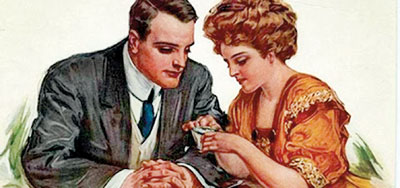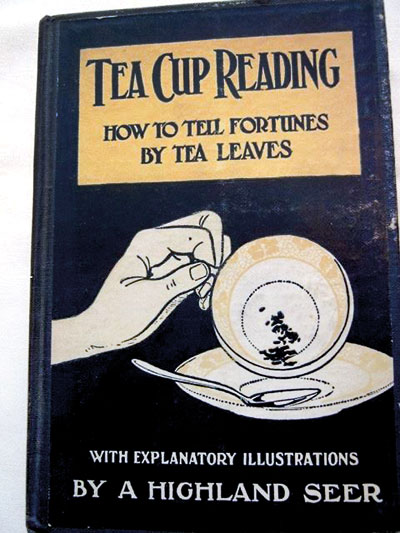A cuppa of fortune
 The practice of reading fortunes from tea leaves comes from the days before tea bags took the fun out of tea time and real tea made with leaves was served without a strainer, and without milk. The leaves remaining in the cup after the liquid had been drunk were supposed to reveal the future.
The practice of reading fortunes from tea leaves comes from the days before tea bags took the fun out of tea time and real tea made with leaves was served without a strainer, and without milk. The leaves remaining in the cup after the liquid had been drunk were supposed to reveal the future.The name for this arcane expertise is Tasseography. Itâs an odd word not found in the Oxford English Dictionary but means the art of divining oneâs fortune, or the future, by means of reading tea leaves. The wordâs derivation is said to come from the French for cup (tasse) or from the Arabic (tassa). To this has been added the Greek suffix graph referring to writing and, thus, interpretation.
Since Sri Lanka has been producing good tea for nigh on 150 years, we could expect to find experts in telling fortunes in tea leaves here. However, perhaps it is the way tea is usually made in Sri Lanka — either as hot water strained into a cup through tea leaves, as a milky beverage, or from tea bagsâthat has rendered tasseography extinct.
Tasseography, although it seems evocative of the Victorian era and peopleâs belief then in the supernatural, sĂ©ances and mediums, has its roots, like tea, in ancient China. The tale is told of a Chinese princess in 229BC who observed the patterns of leaves at the bottom of her tea cup and asked the court seer to determine their meaning. She was apparently more impressed with his interpretation of her future through the tea leaves than through the stars so she gave up astrology for teomancy (another name for the art of tea leaf reading).
In the 17th century when tea from China became a popular drink in Britain, itinerant fortune tellers who travelled to village fairs and used a variety of objects to predict someoneâs fortune, realised the value of tea as an income resource. Drinking tea was a familiar experience and a pot of tea could be shared with clients before the leaves were read, the fortune told, and the seerâs palm crossed with silver.
That fortune telling from tea leaves began in China is important as the Chinese made tea only with the addition of hot water, not milk. To read a fortune properly from Ceylon tea, it has to be done with a cup of plain tea poured from a teapot and served without milk. What grade of tea you choose is important. The popular Dust is too small a grain and, anyway, needs milk to make it drinkable. The best could be Orange Pekoe, a well twisted leaf that yields a delicate brew refined in taste. However, those leaves might be too large to pass through a teapotâs spout or result in a dense residue in the cup that is impossible to interpret.
A small particle size like Pekoe, a curly leaf, or Broken Orange Pekoe (BOP), a popular brew with a finer leaf, are probably best. Tea from an opened tea bag is definitely not suitable. It has to be the real leaf. The tea must be made in a tea pot and poured directly into the tea cup, not filtered through a strainer. The leaves sink to the bottom, and thatâs where the future lies.
The idea is to enjoy a cup of tea with friends as the camaraderie of sharing a pot of tea inspires the enchantment of the moment of fortune telling. For best results, itâs preferable to use a light coloured tea cup without a pattern so shapes can be discerned more clearly. After drinking the cup of tea the technique requires the tea leaf reader â the seer — to study the leaves that remain.
A book called âTea Cup Reading and the Art of Fortune Telling by Teaâ by a writer hiding behind the pseudonym of âA Highland Seerâ published in 1881 gives the way to do this. âThe ritual to be observed is very simple. The tea-drinker should drink the contents of his or her cup so as to leave only about half a teaspoonful of the beverage remaining. He should next take the cup by the handle in his left hand, rim upwards, and turn it three times from left to right in one fairly rapid swinging movement. He should then very slowly and carefully invert it over the saucer and leave it there for a minute, so as to permit of all moisture draining away.â

Then swiftly lifting off the cup from the saucer, turning it the right way up and, keeping the handle pointing at the person whose fortune is being read, the seer contemplates the leaves that remain in the cup. For the uninitiated, the clump of damp leaves at the bottom will seem exactly that: a mess to be chucked out in the garden as plant fertiliser.
A seer, of course, will see a story in the leaves. It takes intuition as well as an imaginative eye to make sense, but it can be done and there are established guidelines to help.For instance, a single leaf at the rim of the cup is highly auspicious. Leaves sticking to the side of the cup indicate an impending and sudden change. Straight lines signify peace, while wavy lines indicate an uncertain period. Leaves bulked together are supposed to signify wealth and prosperity.
Sometimes there will be images that are clear to interpret, such as a bird or a ring or even a heart. Small dots around an image signify its importance. I have studied three different manuals about interpreting tea leaf images and they agree on only a few definitions.A flying bird indicates good news from afar; a sword signifies certain disagreements, even a (court) battle. A heart, of course, is the sign of falling in love but whether a ring means marriage or is actually a lifebuoy (safe sea travel) is up to the seer to decide. Where a tree is seen, it could mean temptation (a Biblical reference) or improvement (growing). A question mark represents a need for caution while an exclamation mark clearly indicates a need to be bold.
Itâs fun to practise with your own cup of tea. Gradually you will define shapes in the muddle of leaves at the bottom of the cup. Itâs the shapes of the leaves themselves, not the white spaces between them, that are revealing. Use your imagination to arrive at what you think an image represents and what it means. Gradually youâll find you have developed a skill that might amuse your friends, even if they donât believe the future you see for them.
Of course, if the future doesnât look good, itâs an excuse to brew another pot and hope for a better fortune in the next cup of tea.


